Introduction
Over the last few months, the news media has continually bombarded us with coronavirus reports that focused on business shutdowns, layoffs, unemployment insurance and benefits, and our future financial prospects. Most people, during this challenging time, changed existing or created personal or family financial budgets and livelihood plans to cope with survival now and prospering after an exit from the restrictive conditions. At the same time, the business community experienced an almost complete shutdown or reduced closure with decreased sales, and potential losses faced a defining moment on identifying and enabling the changes necessary for business sustainability and a return to profitability.
Whatever the future brings, the Heraclitus quote “Change is the only constant in life” will be very germane in societal and workplace relationships and activities.
The COVID-19 propelled the federal and state governments to make substantial interventions in people’s family, social, and business conditions. In response and sometimes leading the way, business leaders adjusting their work policies and practices to the changing needs of their employees, customers, and supply chain partners, while traversing a sea of known and unknown risks. Organizations, large and small alike, supported the governmental ‘stay at home’ guidelines and was quick to institute plans for employees to work from their residences virtually with advanced remote digital connectivity and collaboration solutions.
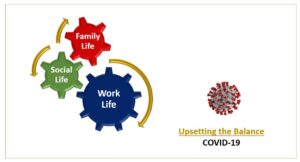
In many ways, the current pandemic is a reminder of the significant social and business disruption of the 9/11 terrorist attacks and the 2008 financial disaster. These and other past historic disasters reoriented society. They changed personal behaviors in enduring ways, from how people view their economic and health wellbeing, personal safety, and security, where they reside and work, and how they travel and plan vacations. At a later time, life will return to a ”new normal work experience” directly influenced by various approaches and ways that proved valuable during the lockdown. Will the permanent adoption of these practices and work conditions be in the best interests of both the business communities and the employee populations?
“The COVID-19 pandemic is a full-stop on business as usual and a launching pad for organizations to become virtual, digital-centric, and agile—and to do it all at a lightning-fast speed.”
McKinsey & Company
COVID-19 has forever changed the workplace dynamic and generated a rare opportunity for companies to initiate trailblazing business pivots with value-add transformation. History shows that successfully addressing a current business crisis requires a renewed and straightforward strategic response versus repurposing previously prepared plans. Undoubtedly the uncertainty and the usual array of internal and external variables will influence a company’s go-forward business strategy to regroup, resurrect, and reopen. Rapid decision-making is mission-critical than ever for organizations to respond and adapt quickly to a new set of business imperatives resulting from particular crisis aftermaths.
“Slow productivity growth and a lack of focus on efficiency and productivity has been at odds with the economic growth of the past decade. COVID-19 could drive changes that require executives to take a closer look at operations of the organization, from out-of-date products to bureaucratic roadblocks.”
Gartner
In the current environment, business leaders charged with resuscitating and resetting their market presence should avoid making decisions in a vacuum concentrating solely on COVID-19. A practical approach would be to conduct an enterprise-level examination and generate change initiatives that embrace the ‘sweet spot’ between the company’s strengths and opportunities and weaknesses and threats. It would not be an overstatement to indicate that a majority of businesses were experiencing a host of internal and external disorders before the onset of the pandemic. As enterprises assess and navigate through an array of post-pandemic priorities and challenges, the strategic focus must quickly address a return to full production and creation of solid groundwork for evolving the business to the new normal operating model with hands-on leadership and employee inducements.
“It is not the strongest of the species that survives, nor the most intelligent that survives. It is the one that is most adaptable to change.”
Charles Darwin
Enterprise Strategic Assessment
What will be COVID-19’s long-lasting effect on the business community with projected changes in the economy, regulatory environment, technology adoption, and consumer purchase behaviors? What exactly will the new standard work practices look like post-pandemic? The end of the stay-at-home situation will not allow the business to return fully to prior work routines, nor will it be universal across the board. The practice of working remotely and conducting web conference meetings is nothing new. Remote work was first established in the 1980s and has been used selectively by an array of industry segments and functions, including programming, CAD, business and technical support, sales activities, and customer services. Except for essential frontline employees, the global workforce by governmental edict is working from home. Gartner reported that “88 percent of organizations have encouraged or required employees to work from home due to coronavirus.”
“Remote working was gaining currency before the crisis, but the pandemic has shown that telecommuting is here to stay. A recent Gartner CFO survey revealed that almost three in four CFOs plan to “shift at least 5 percent of previously on-site employees to permanently remote positions post-COVID-19.”
McKinsey & Company
With COVID-19, a revolutionary shift from workers reporting to a physical work site daily to jumping out of bed and logging-on virtually to their workstation has taken hold that should be a strategic fixture going forward. It is interesting to note that a substantial increase in remote work experiences resulted in the change or modification of many corporate policies, processing, and practices primarily based on digital solutions. As a result, many organizations are reporting streamlined processing, removal of unnecessary departmental or function silos (or building bridges across the silos), an increase in productivity, reduction of the pre-sales life cycle, and increased customer loyalty facilitated by empowered employees.
The most significant value of the crisis-fueled movement to a remote work environment is the prodding of the corporate leadership to revisit and rethink the approach to workplace ethos, strategic initiatives, processing, and customer experiences. With rescind of stay-at-home directives, there is a priority for companies to be proactive, rather than reactive, in planning for the future. It would be a disservice to the investment and employee effort invested during the remote working time to disregard the valuable lessons learned and revert to traditional status-quo practices.
Successful companies need to conduct an enterprise strategic assessment smartly, identify changes to both the near term and long-term business environment and adapt their corporate culture, strategies, and operating model to the realities presented by economic and market sensitivities.
“For leadership teams, the recovery will mean restarting—in some cases, reinventing—operations in an unstable world of shifting conditions. The leading companies will be defined by their ability to balance resilience, adaptability, and prediction. They’ll advance where they can, retreat as soon as they must, and adapt as needed. “
Bain & Company
A practical post-COVID-19 enterprise strategic assessment encompasses the below internal and external elements.
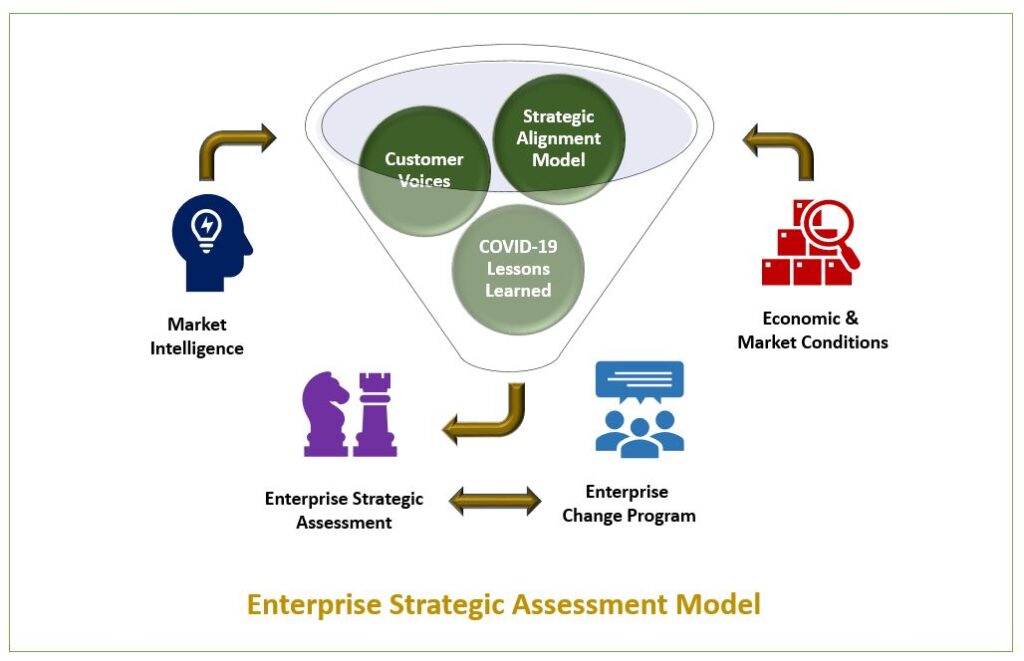
During the physical business lockdown, there was a significant amount of workplace experimentation, leading to a variety of innovative and productive workplace practices implemented. As a result, the ‘new normal’ going forward will likely include many new and changed practices that will alter people’s understandings and behaviors to the work experience.
Outlined in the below table are the COVID-19 influenced practices recognized as valuable lessons learned that represent in whole or part a critical component of a company’s future enterprise strategic assessment.
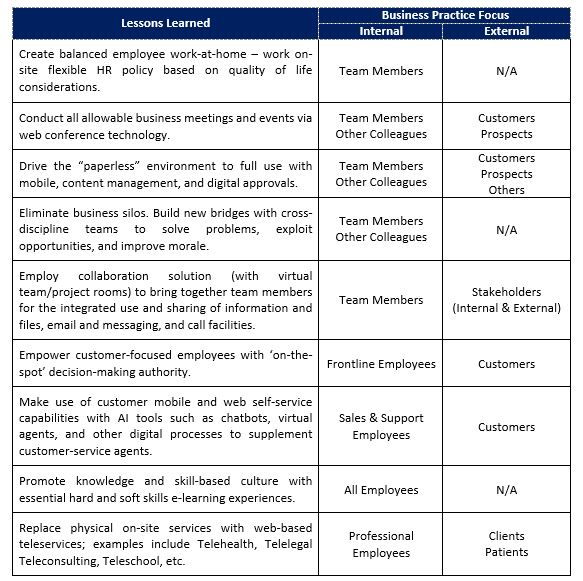
“92% of business leaders surveyed say their organizations have experienced a major transformational change in the last few years.”
Microsoft
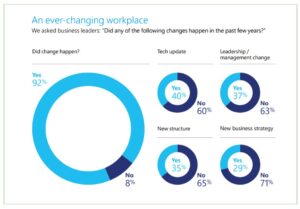
Types of Business Change
There are many issues to consider in successfully managing business change within a crisis environment. The first step in developing and setting-up a formal change program is identifying the type of planned modifications to the business.
The practice of introducing change to a business must be carefully enabled by the management team and start with an awareness of types of change and the desired outcome that fits with the company’s culture, personality, and strategic requirements. Understanding the change categories and knowing how they will aid in determining the appropriate path in setting up the change program.
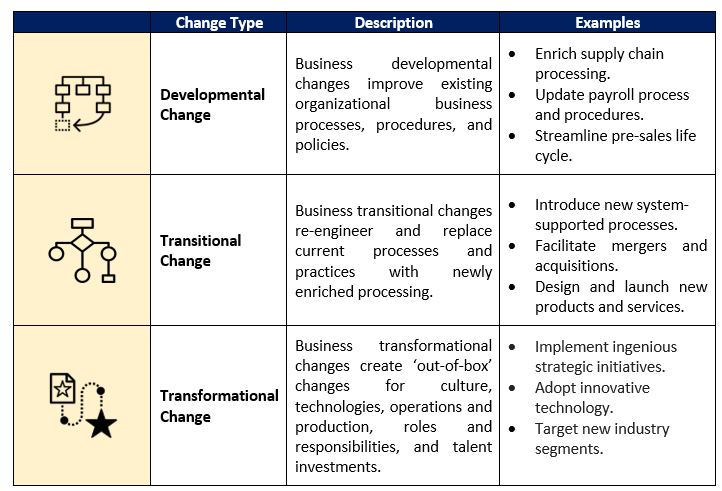
” A Bain survey of executives and workers across the globe conducted from late April to late May found 69% of respondents reported an increased focus on initiatives that matter most for our organization. Another 61% reported a reduction in noncritical meetings and 54% the elimination of low-value activities.”
Bain & Company
The Change Program
The results of the Enterprise Strategic Assessment provides the Change Program with a compelling start with a well-documented case for change. There are a variety of productive methods and tools employed with the set-up and conduct of change programs. However, the supporting conditions and context of these programs are typically unique to the targeted organization. Experience supports that there is no explicit calculus and procedures to drive successful change initiatives. In any case, the program structure selected must demonstrate consistency in dealing with the organizational environment and strategies as aligned with participating and supporting stakeholders’ beliefs and requirements.
Embracing standardized change methods across the enterprise provides the stage for permanent use and enrichment of ‘best practices’ for discovering and developing future cases for change and implementing appropriate responses. The outcome of a formal change program provides accountability with traceability of strategic goals with resultant deliverables and benefits.
The appropriate board and executive leadership must be highly-visible and genuinely ‘walking the talk’ throughout the program for urgent considerations and adjustments to corporate culture, business and technology strategy, organization, and business and support processes as required. It is also essential that the management team speak in unionism and continually exhibit program commitment through their participation and valuable contribution.
“Change management is the practice of applying a structured approach to transition an organization from a current state to a future state to achieve expected benefits.”
The Association of Change Management Professionals (ACMP)
The change program’s starting point is generally obtaining the organization’s open and honest responses to a set of traditional business analysis queries that support the why who, how, what, and when of the program’s underlining problem or opportunity. They include:
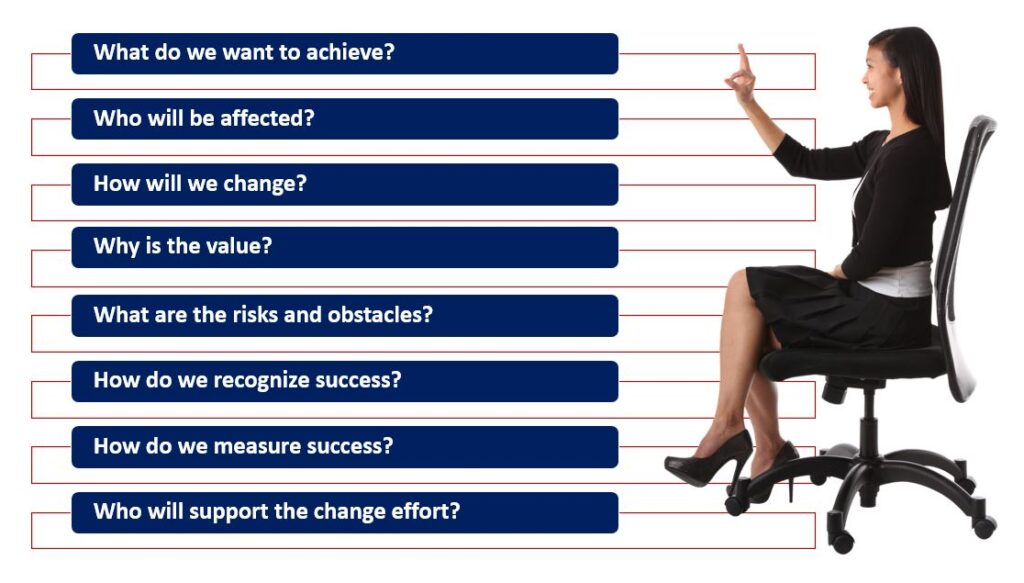
“Discontent is the first necessity of progress.”
Thomas A. Edison
To efficiently handle the changing economy and market changes and challenges, shifting technologies, unpredictable customer requirements, and new competition, companies must learn to understand change catalysts and how and when to change. An effective change program plan incorporates the following components.
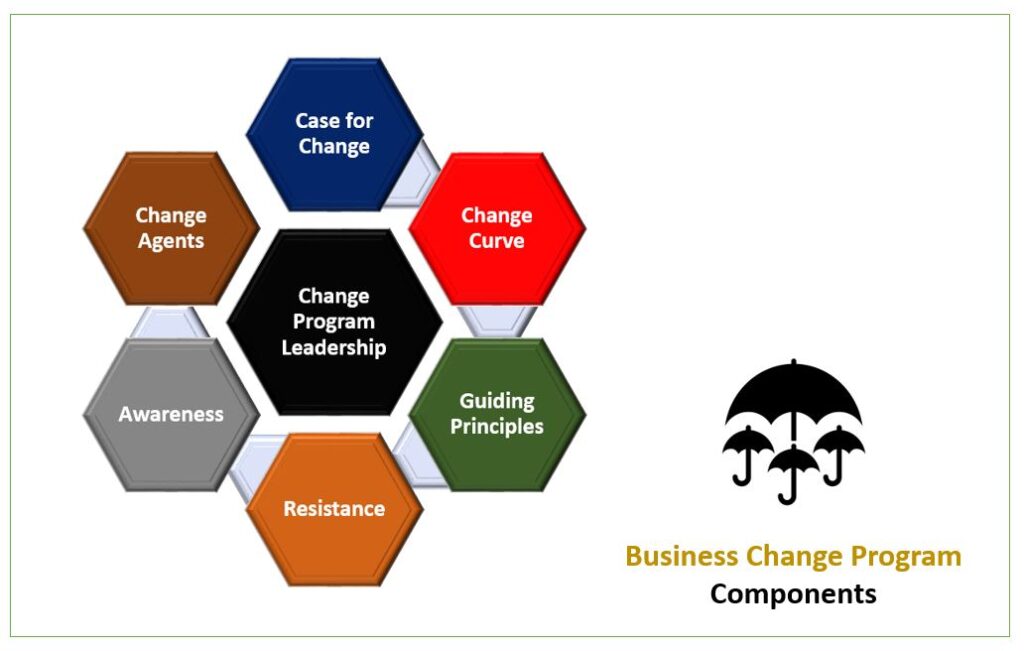
“Organizational culture may seem invisible during prosperous times, but in moments of crisis, its presence can be seen clearly in the collective behaviors that either help a company pull together and get things done or lead to inertia, confusion, and even mistrust.”
McKinsey & Company
It is a known fact that organizations do not change, people do, through acceptance of the need to modify personal behaviors. Required employee behavior changes need to be explicit and practical and include “Moments-of-Truth” relevant to how individual employees handle future internal and external interactions and decision-making. It is also critical to be transparent, during the change program, with all employees, stakeholders, and customers aware of what is at stake, the impacts, and why the business is making a pivot at this point.
The critical change program components descriptions follow below.
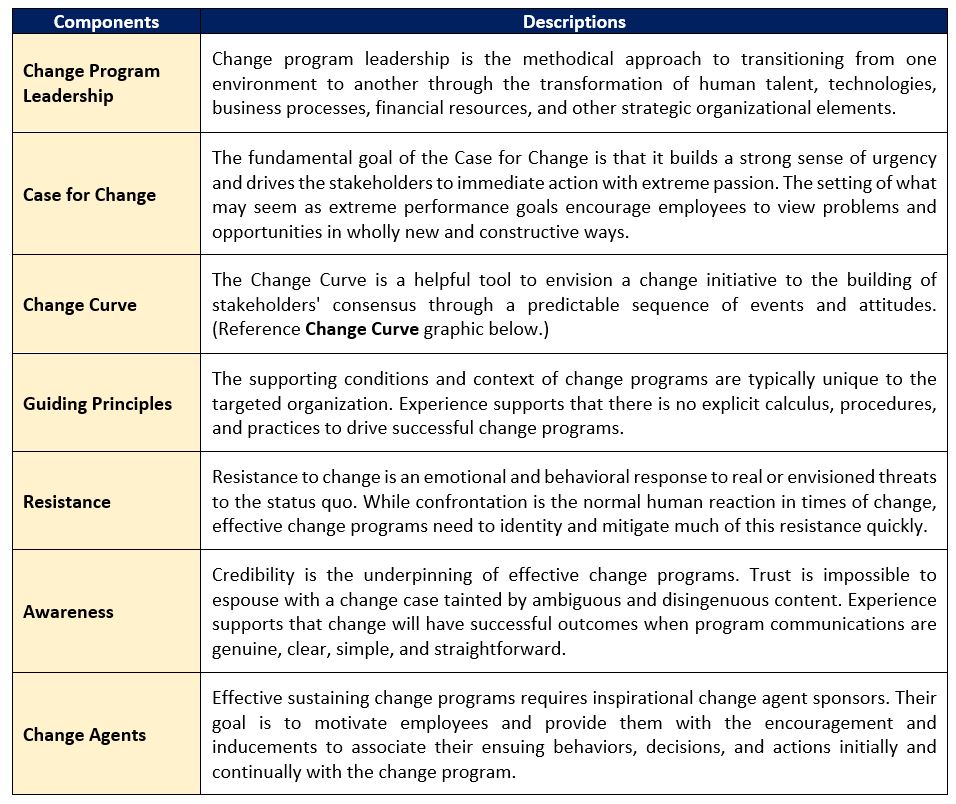
“Every human has four endowments – self-awareness, conscience, independent will and creative imagination. These give us the ultimate human freedom. The power to choose, to respond, to change.”
Stephen Covey
The Business Change Curve Model
The business change curve model is a tool used to understand the phases of personal transition change within the business environment. The change curve typically describes an array of progressive separate stages, starting with shock and ending with integration. The original model, created by Elisabeth Kubler-Ross in 1969, demonstrates how people deal with the report that they have a terminal illness. Nowadays, this model, broadened and modified and repurposed, and used in a business context, projects a person’s progression and responses through workplace change situations.
One of the most vital actions in dealing with a business change is to normalize the reaction to the differences from the current and underlining conditions quickly. The value of the change curve is essential to this requirement. It pinpoints the position of the change on the bend so that a definite forward plan is correctly planned and can successfully react and resolve the identified differences.
A fundamental principle for business change situations is an understanding that resistance is the norm. It is not that a segment of the employee population are inherently stubborn and want to stop progress. It is just that they have developed defense or coping mechanisms to manage change effectively. It is also essential to know that people do not linearly move through the curve stages. Still, instead, they can reside in multiple stages simultaneously and sometimes regress or progress differently.
As companies navigate through a change program, they usually face the fluctuations of the change curve, as illustrated in the below-customized version of the Kubler-Ross Curve.
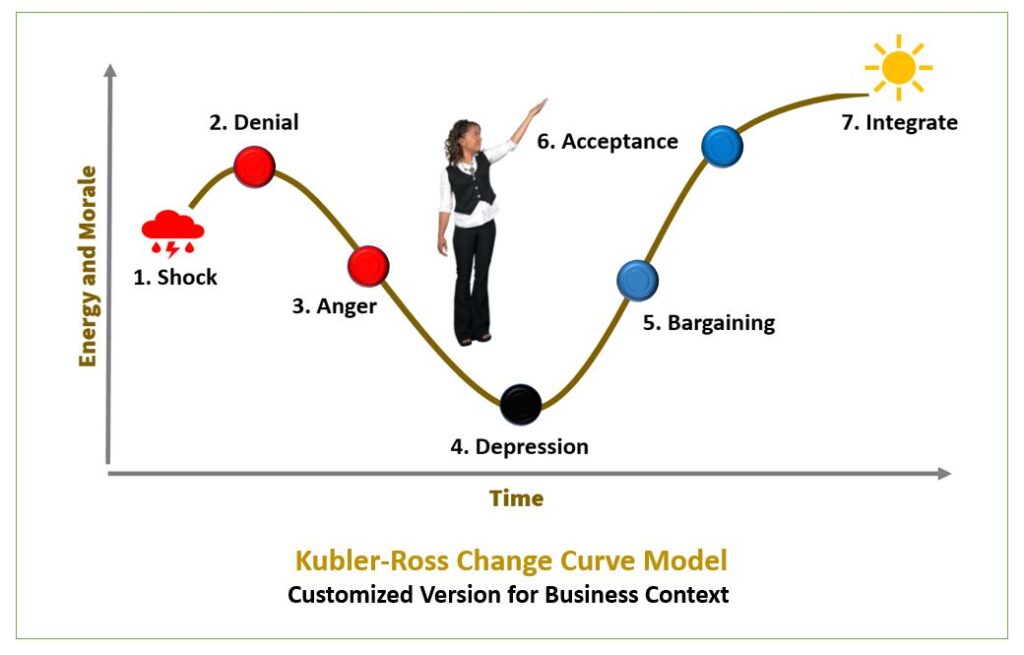
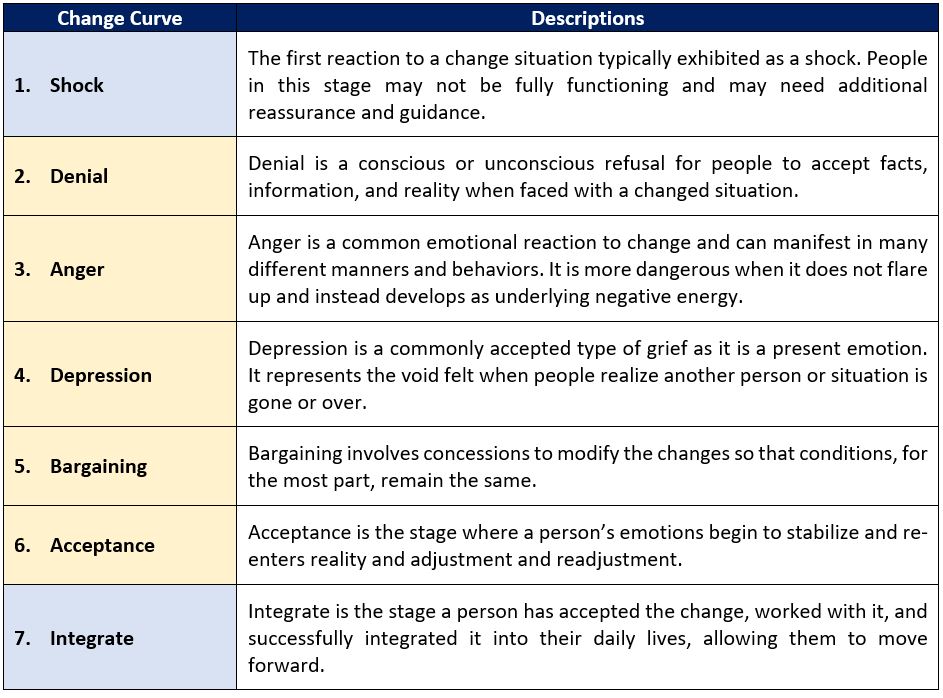
“We cannot solve our problems with the same thinking we used when we created them.”
Albert Einstein
The Way Forward
At Knowledge Compass we bring together nearly four decades of thought leadership in business and technology strategy, the latest tools and best practices, and a seasoned consultant team with the competencies and talent to help our clients improve productivity and profitability of all enterprise business and support activities.
Knowledge Compass explores and develops valuable new insights from business, technology, and science by embracing the powerful technology of ideas and brainstorming. Our consultants engage customers in challenging discussion and experimentation to expand the boundaries of business science and practice and translate creative ideas into practical solutions from within and beyond business.
Working with Knowledge Compass means a collaborative approach to understanding your current business model, strategies, and key business requirements and goals.
We enable organizations to transform and deliver improved value by ensuring employees adapt and make the most effective use of changes in culture, strategy, infrastructure, and processing. Our consultants have a deep understanding of the social and business factors that support the realization of successful change programs.
Knowledge Compass provides consulting services with the use of an array of Frameworks, Analyses Tools, and Interactions from their Best Practices Consultant Toolbox.



0 Comments